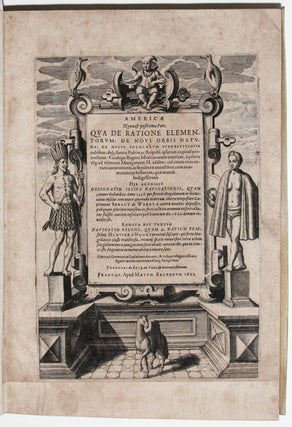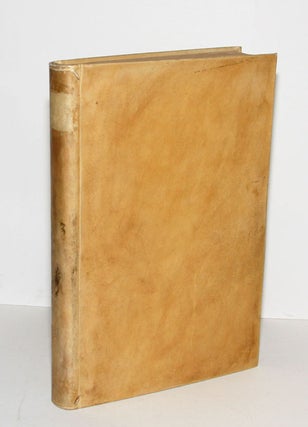Americae Nona & Postrema Pars.
Folio, 362 pp., with 1 map outside collation; (1) f., xxv numbered plates; 100 pp (misbound after plates); (1) f., XIV plates. Bound in later vellum. Blank lower margin of title and following 2 leaves re-margined; typical light browning to text leaves almost always seen in this series, but generally not affecting maps and plates, which are in very good impressions. Good.
First Latin edition of the ninth part of the De Bry’s Grand Voyages, containing an extremely important account of a Pacific voyage by Olivier van Noort -- as well as much ethnographic material relating to the indigenous Indian culture of Mexico and Peru. As the importance of the America material in all of the De Bry volumes is extremely well-known -- “the cornerstone of every library of Americana” (Penrose) --, let us focus on the Pacific material. Like the earlier parts of the De Bry series, this volume provided the majority of European readers with the first detailed illustrations of many of the locales described, particularly of the Philippines and other Pacific locales. In fact, according to Lach, the van Noort account contains “the earliest first-hand Dutch descriptions of the Ladrones (Marianas), the Philippines, and Borneo.” -- Asia III.1.442. On the political front, it was the first publication to inform Europe that the Spanish monopoly of the Pacific was being aggressively challenged by the Dutch, including an illustration showing the battle of Manila.
Van Noort journeyed to the Moluccas via the Straits of Magellan, entering them in September of 1599 but, owing to disastrous weather conditions in that precipitous region, it did not reach the Pacific until the end of the following February. Continuing along the coast of Chile, he stopped at Peru, New Spain, and eventually reached the Mariana Islands, Manila, Borneo and Java.
“Van Noort describes the Ladrones very much as did the earlier Spanish writers: the people are superb swimmers, incorrigible thieves, live without law, hold women in common, and subsist on bananas, coconuts, sweet potatoes and sugar cane, which they gladly trade for pieces of old iron. The Dutch writer reports on the visible damage suffered by many of the islanders from the Spanish pox (syphilis)... the Dutch were impressed and somewhat bewildered by the vast number of Philippine islands. To thread their way from the San Bernadino Straits to Manila they seized both native canoes and a Chinese junk to obtain pilots. They notice the usually naked and tattooed natives, the houses on stilts, and the many boats and ships which bring what is called tribute from the outlying islands to the Spanish at Manila. From a captured Chinese pilot they learned much about Manila’s size and fortification and about its large Chinese settlement. Luzon is thought to be larger than Scotland and England combined.” -- Lach, III.1.442.
Chirino (Cartography of the Philippines) includes 4 maps in the present volume, all notable for their early date: #9 Ladrones insula descriptio; #10 Quid in Ladrones insula Hollandis acciderit; #11 De sinu Baye la Baye, which he terms the “first scene of Albay in southern Luzon province, where Admiral van Noort paused on route to Manila. Dutch ship is anchored in the bay, with a tattooed native holding a bow and arrow, while another wears shorts”; #13 Hollandorum cum Hispanis ante Manillam pugna navalis.
The van Noort was first published in Dutch, in editions of 1601 and a corrected edition of 1602. As the first Latin edition, this account in the de Bry series was the first to gain a general European readership.
* Church 168; Griffin, Bibliography of the Philippines, p. 24; Medina XXX; Chirino, Cartography of the Philippines p. 20 & pp. 79ff.
Sold



